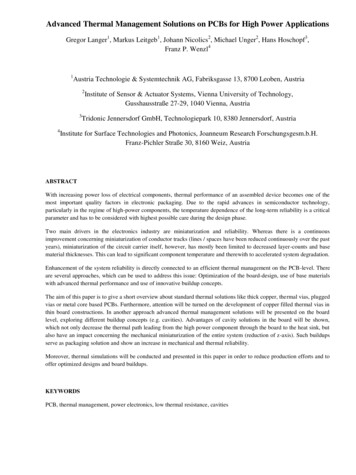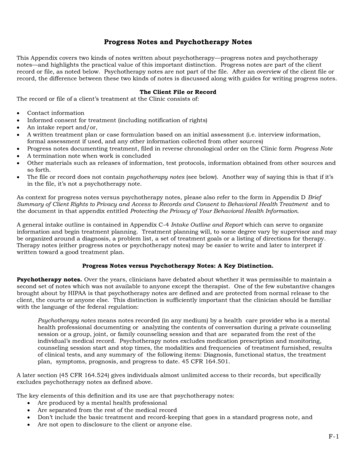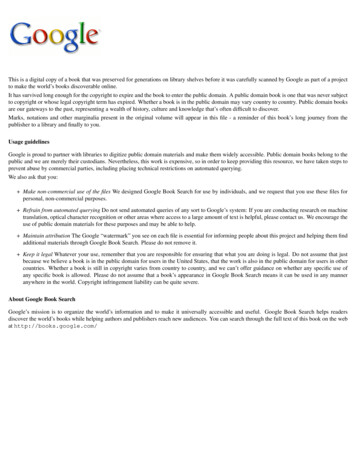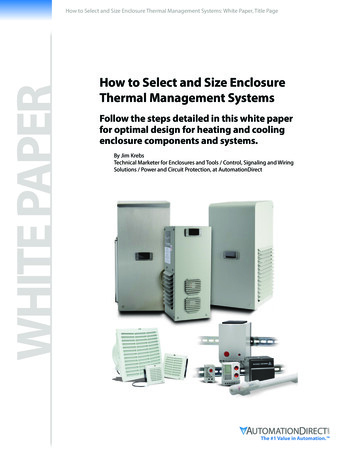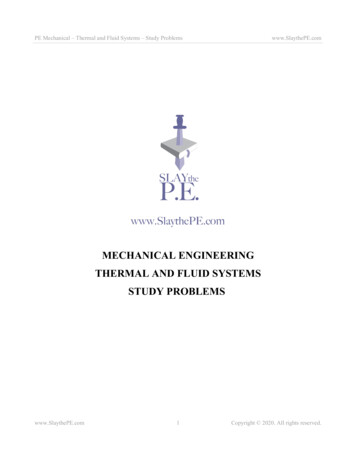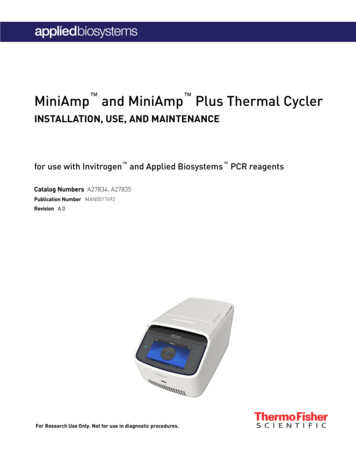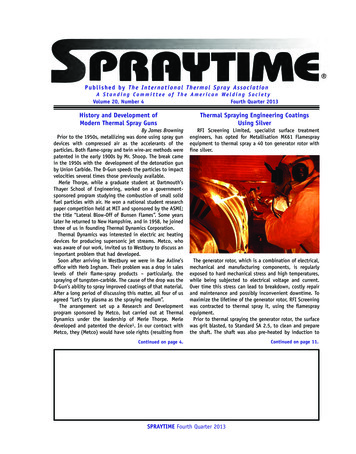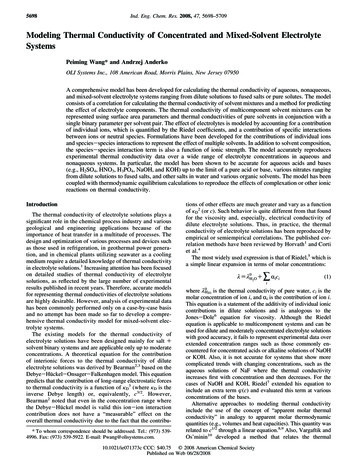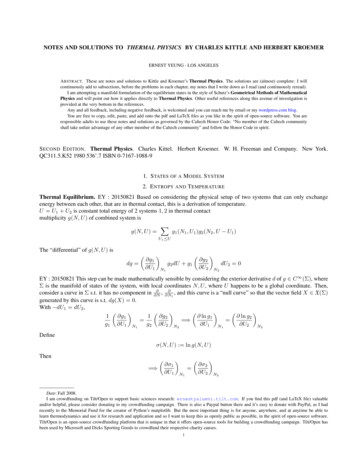
Transcription
NOTES AND SOLUTIONS TO THERMAL PHYSICS BY CHARLES KITTLE AND HERBERT KROEMERERNEST YEUNG - LOS ANGELESA BSTRACT. These are notes and solutions to Kittle and Kroemer’s Thermal Physics. The solutions are (almost) complete: I willcontinuously add to subsections, before the problems in each chapter, my notes that I write down as I read (and continuously reread).I am attempting a manifold formulation of the equilibrium states in the style of Schutz’s Geometrical Methods of MathematicalPhysics and will point out how it applies directly to Thermal Physics. Other useful references along this avenue of investigation isprovided at the very bottom in the references.Any and all feedback, including negative feedback, is welcomed and you can reach me by email or my wordpress.com blog.You are free to copy, edit, paste, and add onto the pdf and LaTeX files as you like in the spirit of open-source software. You areresponsible adults to use these notes and solutions as governed by the Caltech Honor Code: “No member of the Caltech communityshall take unfair advantage of any other member of the Caltech community” and follow the Honor Code in spirit.S ECOND E DITION. Thermal Physics. Charles Kittel. Herbert Kroemer. W. H. Freeman and Company. New York.QC311.5.K52 1980 536’.7 ISBN 0-7167-1088-91. S TATES OF A M ODEL S YSTEM2. E NTROPY AND T EMPERATUREThermal Equilibrium. EY : 20150821 Based on considering the physical setup of two systems that can only exchangeenergy between each other, that are in thermal contact, this is a derivation of temperature.U U1 U2 is constant total energy of 2 systems 1, 2 in thermal contactmultiplicity g(N, U ) of combined system isXg(N, U ) g1 (N1 , U1 )g2 (N2 , U U1 )U1 UThe “differential” of g(N, U ) is dg g1 U1 g2 dU g1N1 g2 U2 dU2 0N2EY : 20150821 This step can be made mathematically sensible by considering the exterior derivative d of g C (Σ), whereΣ is the manifold of states of the system, with local coordinates N, U , where U happens to be a global coordinate. Then, consider a curve in Σ s.t. it has no component in N, N, and this curve is a “null curve” so that the vector field X X(Σ)1generated by this curve is s.t. dg(X) 0.With dU1 dU2 , 1 g2 ln g1 ln g21 g1 g1 U1 N1g2 U2 N2 U1 N1 U2 N2Defineσ(N, U ) : ln g(N, U )Then σ1 U1 N1 σ2 U2 N2Date: Fall 2008.I am crowdfunding on Tilt/Open to support basic sciences research: ernestyalumni.tilt.com. If you find this pdf (and LaTeX file) valuableand/or helpful, please consider donating to my crowdfunding campaign. There is also a Paypal button there and it’s easy to donate with PayPal, as I hadrecently to the Memorial Fund for the creator of Python’s matplotlib. But the most important thing is for anyone, anywhere, and at anytime be able tolearn thermodynamics and use it for research and application and so I want to keep this as openly public as possible, in the spirit of open-source software.Tilt/Open is an open-source crowdfunding platform that is unique in that it offers open-source tools for building a crowdfunding campaign. Tilt/Open hasbeen used by Microsoft and Dicks Sporting Goods to crowdfund their respective charity causes.1
Temperature. T1 T2 - temperaturesof 2 systems in thermal equilibrium are equal. σ[?].T “must be a function of UN 1 σ kBT U NExperimentally, kB 1.381 10 23 J/K 1.381 10 16 ergs/K.Now 1 σ τ kB Tτ U NProblems. Solution 1. Entropy and temperature. σand σ(N, U ) log g(N, U ). Given g(U ) CU 3N/2 ,(a) Recall that τ1 UN,Vσ(N, U ) log CU 3N/2 log C 3Nlog U2 σ3N 113N U τ U2 Uτ2(b) 2σ U 2 N 0? 2σ U 2 N3N2 1U2 0Solution 2. Paramagnetism.U (s) U1 (s1 ) U2 (s2 ) 2mB(s1 s2 ) 2mBs or s U 2mBi.e. potential energy U (s) 2s · mB.For s N , then2 g(N, s) ' g(N, 0) exp 2s /N g(N, 0) expσ(N, U ) ln g(N, U ) σ0 U 22(mB)2 N U2 1where σ0 ln g(N, 0)2m2 B 2 N σ U 11 2 2τ U Nm B NWhat is the thermal equilibrium value of this N -spin system of fractional magnetization? If U denotes hU i, thermal averageenergy, we also get the thermal average spin excess.hU i h 2mBsi 2mBhsi τ m2 B 2 NmBN U2hsiSolution 3. Quantum harmonic oscillator.(a) Result from Ch. 1: g(N, n) Let N 1 N g(N(N n 1)!n!(N 1)! . n)! 1, n) (Nn!N! .(N n)! ln (N n)! ln (n!) ln (N !)n!N ! (N n) ln (N n) N n n ln n n N ln N N (N n) ln (N n) n ln n N ln Nσ(N 1, n) ln g(N 1, n) ln(b) Let U denote total energy n ω of oscillators.UU n ω or n ωσ(N, U ) (N At τ ,1τ UUUU) ln (N ) ln N ln Nωωωω σ U N . 11U1 U1 ln (N ) ln lnτωωωωω2 NωNω 1 or U Uexp (ω/τ ) 1
Solution 4. The meaning of “never.”Suppose 1010 monkeys.(a) Hamlet represents one specific ordering of 1015 with 44 possibilities for each character. The probability of hitting 11 100000 upon Hamlet from a given, random sequence is 44. Given that log10 44 1.64345, then44100000101.64345 44 or 10 1.64345 44 1 so then 1000001 10 16434544(b) (age of universe) ·10 keyssecond 10 keyssecond 1 hamlet510 characters 1018 s 1019 keys · 1010 monkeys 1029 keys typed out 1019 keys 1024 possible “Hamlets”From part (a), the probability that a given, random sequence is Hamlet, 10 164345(1029 characters)(10 164345 ) 10 164316 164345Note, I think that the probability should be (1029 characters) 1015 Hamlet) 10 164321characters (105Since we are considering the number of “Hamlet”, 10 character sequences.3. B OLTZMANN D ISTRIBUTION AND H ELMHOLTZ F REE E NERGYcf. Example: Energy and heat capacity of a two state system, pp. 62 of Kittel and Kroemer [1]. Kittel and Kroemerintroduces the heat capacity very early, specific to this example.Definition 1. heat capacity CV at constant volume is defined as σ(1)CV : τ τ VRecall the thermodynamic identity (which is introduced many equations later):dU τ dσ pdV Ω1 (Σ)where Σ is a manifold of states of all systems. i.e. no componentConsider local coordinates of Σ, (σ, V ). Consider curve c : R Σ s.t. c generates a vector field ċ σ̇ σc(τ ) Σin the V direction. Notice the prescient choice of parameter τ .Now for internal energy U C (Σ), taking the exterior derivative d results indU U Udσ dV σ V Then applying dU onto vector field σ̇ σ, σdUσ̇ σ τ Uσ̇ σ̇τ 0 σNow, U σV V U τ V σ τ τVHence, (2)CV : τ σ τ V U τ VEY: 20150825 Why do we need differential geometry? It’s because I always wondered why you could do this: σ U?CV : τ with τ dσ dU τ σ U τ V τ Vand talk of “differentials.”Definition: Reversible process. EY : 20150824 Mathematically, 1-forms are exact.3
Pressure. Consider coordinates (σ, V ) Σ of manifold of thermodynamic states Σ.Imagine a reversible compression of a cube system (so imagine dV 0; cube’s volume get smaller).σ constant, i.e. dσ 0 (on this curve in Σ) because as particles in cube gets squeezed, less positions particles could sit in,but they get more kinetic energy, more energetic (more momentum squared).Now U U (σ, V ) C (Σ). U dU U σ V dσ V σ dV Again, imagine a curve c : R Σ, connecting 1 state (σ, V ) Σ to another state (σ, V dV ) Σ s.t. ċ V̇ V. U dU (ċ) V̇ V σIntroduce 1-form W Ω1 (Σ) of work done on the cube system from some external agentW pdVso W 0 when dV 0.Then W (ċ) pV̇ dU (ċ) p (3) U V U V V̇σ σConsider another set of coordinates (U, V ) Σ for manifold Σ. Now entropy σ is a function of U, V , as σ σ(U, V ) C (M ), so that σ σdσ UdU VdVVU Consider curve c (U, V ) Σ. Then ċ U̇ U V̇ V. For this curve c, σ is constant, meaning dσ(ċ) 0 (it’s a “nullcurve” of dσ σ σU̇ V̇dσ(ċ) 0 U V V UNow defineDefinition 2.1: τ(4) σ U VSo then we have τ1 U̇ V U V̇ 0. For the parameter of curve c, choose the parameter to be V , knowing that σ is constanton this curve, or thermodynamic process. Thus 1 U σ σ p orτ V σ V Uτ V U σ (5)p τ σ V UThermodynamicLet σ σ(U, V ) C (Σ). Then Identity. σ σdσ U V dU V U dV Ω1 (Σ). σ σNow recall the quantities we’ve recently used: τ1 : U(this is a definition) and τp V(it comes from the physics,VUof doing work on the system, by some external agent). Then the thermodynamic identity is obtained:Theorem 1.(6)τ dσ dU pdVIdeal Gas: A First Look.4
One atom in a box. one atom of mass M in cubical box of volume V L3 2 2p i p2 ψ ψ2M ψ ψ ny πy nx πx ψ(x) A sin L sin L sin nzLπz π 2 2(n2x n2y n2z ) n 2MLThen the partition function Z1 is XX n 2 π 2 222Z1 exp(nx ny nz ) expτ2M τ Ln(nx ,ny ,nz )Letα2 2 π 2 πor α 22M L τ(2M τ )1/2 V 2/dThen Z ZdnxZ1 0Zdny0In general, Z1 Now dnz exp [ α2(n2x n2y Zn2z )] 3 dnx exp ( α2 n2x )00 3 1/2 3 1/2 31ππ α22α d1/2π2αZ1 π 1/2 V 1/d2 (2M πτ )1/2!dnQV nQ V d/22 πn Mτin terms of concentration n 1/V . M τ d/2nQ : 2π is the quantum concentration.2Problems. Solution 1. Free energy of a two state system.(a)Z 1 e /τF τ ln Z τ ln (1 e /τ )(b) e /τ (F/τ ) τ1 e /τ /τe Fσ ln (1 e /τ ) τ /τ τ(1 e)U τ 2Solution 2. Magnetic susceptibility(a) Remember to calculate the multiplicity in the N -spin system (it’s not enough to sum up exp ( s /τ ) factors).Us M B 2smBM 2smN N N 2s N N N (N N ) 2N NN/2Z X N 2smB expN τs N/2 e N mBτ(1 e2mBτN/2XN2s N/2)N 2N coshN mBτN! exp s ! N2 s ! 2mBsτ NXs 0N!exps!(N s)! 2mBτ Ns 2 where it was crucial to use (1 x)N neglect dropping the s 0 term.PNj 1Nj xj . Note, in changing the sum index, since N is large, we can mBmB m) sinhτττ2 mBM τ 2ln Z N m tanh ττ 2 MNmmBχ sech2 Bττ τ Z 2N (N )(coshN 1 5
(b)For x Mnm mB NmBF τ ln Z τ ln (2 cosh) N τ ln (2 cosh)ττ 2 N τ42 2 tanh mB ln.Now1 tanhy sechy.F Nτln2τ21 x1 x2m2 NτSolution 3. Free energy of a harmonic oscillator(a) X s ω01 (1 e ω0 /τ ) 1Z exp ω0 /ττ1 es 0 ω0 ω0 ω0 /τF τ ln Z τ ln (1 e) ' τ lnfor 1ττ(b) ω0 Fτ ω0 ω0 /τ ω0 /τσ ( e ln (1 e τ ) {ln (1 e ω0 /τ ) )} ω /τ ω/τ00 ττ1 ee 1Solution 4. Energy fluctuations.Xe s βZ 1sPX β s e s /ττ β Z e s βU s β ln Z β 1 Zs 2X τ τ βτ β 2 Z 2 e s β(c) FormBτ1, cosh2mBτ 1. χ βss U β Z β 2 U β 2 β β2 τ βZ( β2 Z)Z ( β Z)2Z2! β2 β2 Z Z β ZZ 2 ! U h 2 i h i2 τSolution 5. Overhauser effect. System S in energy eigenstate En n .P (E) (1)gR (E)dURdUtotSNote UR (α 1) . US . dUd d 1 (α 1) α d in a specific energy eigenstate; gS (n ) 1While gR (UR ) multiplicity of reservoir R with UR energy.Now σR1 EsτandgR (UR ) exp (σR (UR ))RIf dU (α 1) UsmallcomparedtoURR.d τ 2dUR UR (n ) (α 1) d 1σR (UR ((n 1) )) ' σR (UR (n )) (α 1) τ exp (σR (UR (n )) τ1 (α 1) )P (ES (n 1) ) exp (1 α)P (ES n )exp (σR (UR (n )))τSolution 6. Rotation of diatomic molecules.(a) (j) j(j 1) 0 . g(j) 2j 1Remember that Z is a sum over all states, not over all levels. 2XX τd (j 2 j) 0 /τ τ X d 0 /τ j j j(j 1) 0 /τ(e) eZ (2j 1)e dj 0 0 j 0 djj 0j 0UR (ES (n 1) ) UR (n ) (b) For 1 0ττZR (τ ) 0Z0 d 0 /τ xedx2 xdx 6 τ 0 /τ x2 xτ(e) (e 0 /τ )0 0 0
(c) Forτ 01ZR (τ ) 1 3e 2 0 /τ(d) 0τ2U τfor 1U τ τ ln ττ 0 6 0 e 2 0 /ττ12 0 2 0 /τ for1, U τ 2(3e)2 2 /τ 0τ1 3e 01 3e 2 0 /τ U 0CV 1 when 1 τ Vτ 2 /τ ! 2 0 2 0 /τ 2 0 /τ0 2 0 /τ(1 3e) (3e)e 0e 2 0 /τ 2 1222eττ 12 0τ2(1 3e 2 0 /τ )2(1 3e 2 0 /τ )22 CV 6 0For very smallτ 0ln Z τ 1, CV 12e 2 0 /τ(τ / 0 )2 (e) See sketch.Solution 7. Zipper problem.(a) N links. s 0 closed, open.Z NXexp ( s /τ ) s 01 e (N 1) /τ1 e /τ(b) 1 τ .PNZ s 0 exp ( s B)PN 1 1 s 0 ( s )e s β β ln Z hsi Z 1 e /τ e (N 1) /τ ( (N 1) )(1 e /τ ) ( e /τ )( )(1 e (N 1)/ /τ ) 1 e (N 1) /τ(1 e /τ )2 e /τ (e N β (N 1)(1 e β ) 1) e /τ (e N β (N 1)(1 e β ) (1 e (N 1) /τ ))'(1 e β )(1 e (N 1) /τ )(1 e /τ )This still does not give the desired approximation. Consider the following:e β e N β1 e (N 1) β 1 e βe β 1 β N β ((e N βe)(e β 1) (e β )(e β e N β )) (e β (e β N e N β e β e N β ) e β N e N β ) β Z (e β 1)2(e β 1)2Z (e β (N 1)e N β e β N e N β ) (e β (N 1)e N β e β N e N β ) β Z ' β β N βZ(e 1)(e e)e2 β (N e (N 1) β e (N 1) β e β N e N β ) ((N 1)e (N 1) β (e β N e N β )) 2 βe2 β β βe β N β β β Ne (N 1)e N e eeN e (Ne 1)e eNn β e β e βN β βeN βN eN β 'e2 βe2 βe2 βeN β e β ' ( eN β ) e βeN β e β hsi e /τ n πy Solution 8. Quantum concentration. Now Ψ(x, y, z) A sin nxLπx sin yLsinGround orbital: nx ny nz 1.3 π 23 π 2T hψ0 ψ0 i 2m L2m L7nz πzL . p 1i ,p22m1 2m 2 .
where hψ0 ψ0 i 1, ψ normalized. It was normalized in this way:Z0 Z L2nx πx n πx nx sin1 cosxLdnx sin2dnx L202nx πxL L2nx π2 L L20 3LA2 L382hψ ψi A 1 or A2 328L mτ 3/2Recall that nQ 2π .2Consider the condition that there will be a concentration for which the zero-point quantum kinetic energy is equal to thetemperature τ : 3/2 3 2 2/32mτ3 π22mτ2/3 orn πn τorn 2m L22m3π 2 23π 2 2 3/244mτ 3/2 n () nQ23π 2π 3πSolution 9.Partition function for two systems. XX E1 2 E1 E2g(E1 2 ) expZ(1 2) g(E1 E2 ) exp exp τττE1 2E1 E2 E0 XX E2 E1 g(E1 )g(E2 ) expexp Z(1)Z(2)ττE1 E2since systems are independent.Solution 10. Elasticity of polymers.(a) Consider 2s N N ; N N N , 2s N (N N ) 2N N .For 2s, consider 2s N (N N ) 2N N .N 2s N2 g(N, s) g(N, s) N2N 2s N2 .2N ! s ! N2 s !(b) s N l l2(N!) σ(l) ln g N, g N, ln l lNN2ρ2ρ ! 22ρ22ρ ! LNlNlNlNlNlN ln ln } ln (2N !) {22ρ22ρ22ρ22ρ22ρ22ρwhere we used ln(x x) ' ln x x1 x.
Thermal Equilibrium. EY : 20150821 Based on considering the physical setup of two systems that can only exchange energy between each other, that are in thermal contact, this is a derivation of temperature. U U 1 U 2 is constant total energy of 2 systems 1;2 in thermal contact multiplicity g(N;U) of combined system is g(N;U) X U 1 U g 1(N 1;U 1)g 2(N 2;U U 1)File Size: 581KBPage Count: 40

